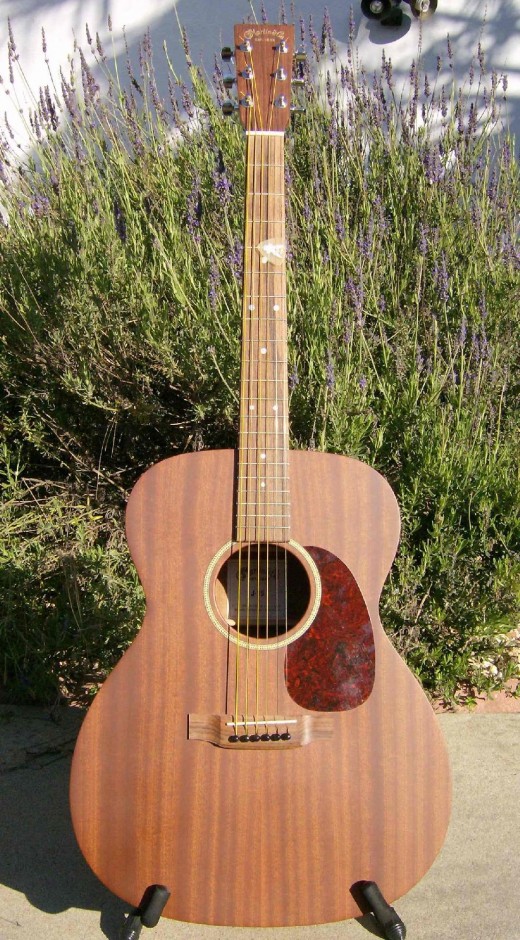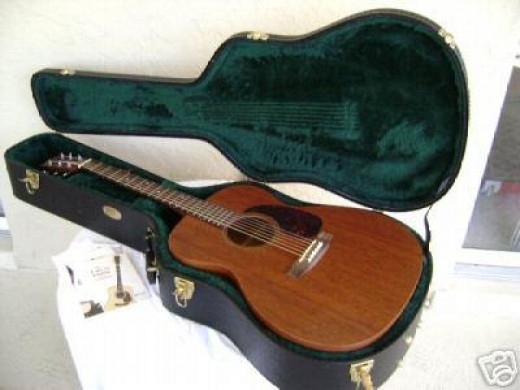The Martin J-15, A Jumbo Sized Inexpensive Masterpiece

Why A Jumbo Guitar?
People come in all shapes and sizes, two sexes, and various ambiguities. In our lives a lot of us get a desire for a time, or for a lifetime, to make music. It's a simple fact the guitar is the most often used and desired instrument[1] of the inspired musician. Every musical instrument is desirable and capable of making beautiful tonal artwork, but for whatever reason, it is the guitar most choose to use to see if they're music making desire is for a time, or forever.
It's a simple fact the acoustic variety of the six stringed instrument we all know and love so well is the more favorable one for many an occasion, and this is certainly due to its not needing any sort of assistance for play from electricity or electrical gadgetry. The larger the guitar, the more sound the guitar can provide would be a general rule, but we all know there are many more factors involved, specifically, the quality of the wood, and the talents and education of the builder. It goes quite without saying that the builders down a C.F. Martin & Company are among the best in the world. Martin guitars was established in the USA in 1833, and probably, the Martin family were building guitars prior to immigrating to here.

Specifications
The Martin J-15 is not constructed with the classic dovetail neck joint, but rather, with the more modern Mortise/Tenon neck joint, which is a more modern, cost and time effective means of connecting the neck of a fine guitar to the body. The guitar is the standard 14 frets clear of the body. This guitar is constructed with all the master workmanship seen in ALL all solid wood construction Martin instruments, but the 15 series instruments are built to be not just heirloom quality instruments, but affordable ones. What this means is some less expensive materials are used. When I say "less expensive," it would be a huge mistake to assume this meant "cheaper." The bridge and finger board or fret board on this guitar are both constructed using rosewood. Rosewood is NOT a lesser wood than ebony for such things, it is ONLY a less expensive wood than ebony.
Now, the tricky thing to discuss with this fine Martin J-15 steel string instrument is this, the woods used for the top and the body. This same bit of issue is the same with all Martin 15 series instruments. Martin regards sapele and mahogany as identical woods. They are nearly the exact same thing, but they are not exactly the same thing. Some 15 series instruments will have one for the body/sides, and the other for the top, or vice versa. I'm told the older Martin 15 series instruments were all mahogany, and the newer ones are all sapele. C.F. Martin guitars and Taylor guitars both consider sapele and mahogany as so very similar as to be the same. This particular subject is one which is often discussed on guitar forums[2], and probably will be for a significant time to come.
This guitar features A frame X bracing, and the braces are made from sitka spruce. The head plate is East Indian rosewood as is the fret board and the bridge. Martin guitars tells me the bridge and/or fret board on some specific instruments will be of solid morado. Electronics are optional on this guitar.
The width of the neck at the nut on this guitar is standard for Martin guitars these days, and it is 1 11/16". The all mahogany sound of this guitar leaves many musicians feeling it is best suited, as all all mahogany guitars are, for playing acoustic and/or country blues. I'm pricing this instrument used on the web at about $700. Needless to say, a new one will cost slightly over a thousand dollars.
Particulars and conclusions
Mahogany is a much lighter weight wood than is rosewood, and this guitar is entirely of mahogany and/or it's very close cousin sapele, all throughout the body. Despite the larger than dreadnought sized body of this fine Jumbo sized acoustic guitar, it's not going to weigh a whole lot. Now mahogany when used in the body is well known to produce a lot of velocity of sound, but what about mahogany as a sound board on an all mahogany guitar like the J-15? Both Koa and mahogany have been used as soundboards or tops to fine acoustic instruments since the 1920's, and if you were to look at my thumbnail image here, you would see I am holding and playing an all mahogany Martin 00-17. Suffice it to say I know about all mahogany guitars, and how they differ from guitars with spruce tops. While mahogany bodies produce a high velocity of sound when compared to rosewood, mahogany tops or soundboards produce a much lower velocity of sound when compared to spruce tops or soundboards.
One could describe the tonality of a mahogany top guitar as subdued, dark, or rather suited to blues music. An all solid wood guitar from a master corporation like Martin is a work of art, and it should be used to further the artistic skills and endeavors of an artist, and this guitar will suit any professional or armature musician very well for all of his or her lives. These jumbo sized guitars being somewhat large, one should typically be certain such an instrument is suited for them, as being able to handle such a guitar could be an issue for someone on the small size of the physical spectrum. All Martin guitars come with a limited lifetime warranty to the original owner and a hard shell case. Thanks for reading.


 1:41 PM
1:41 PM
 Wesman Todd Shaw
Wesman Todd Shaw

0 comments:
Post a Comment